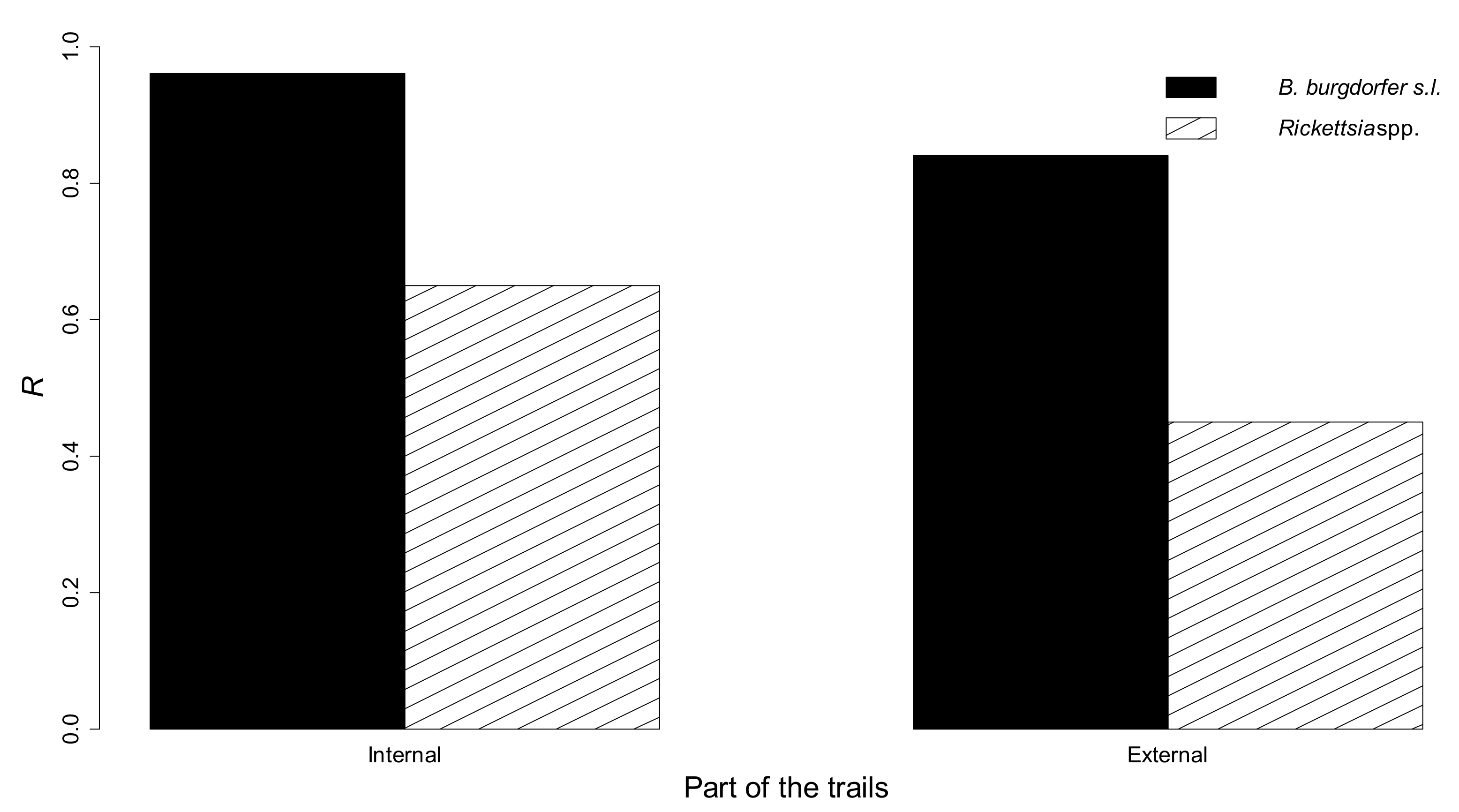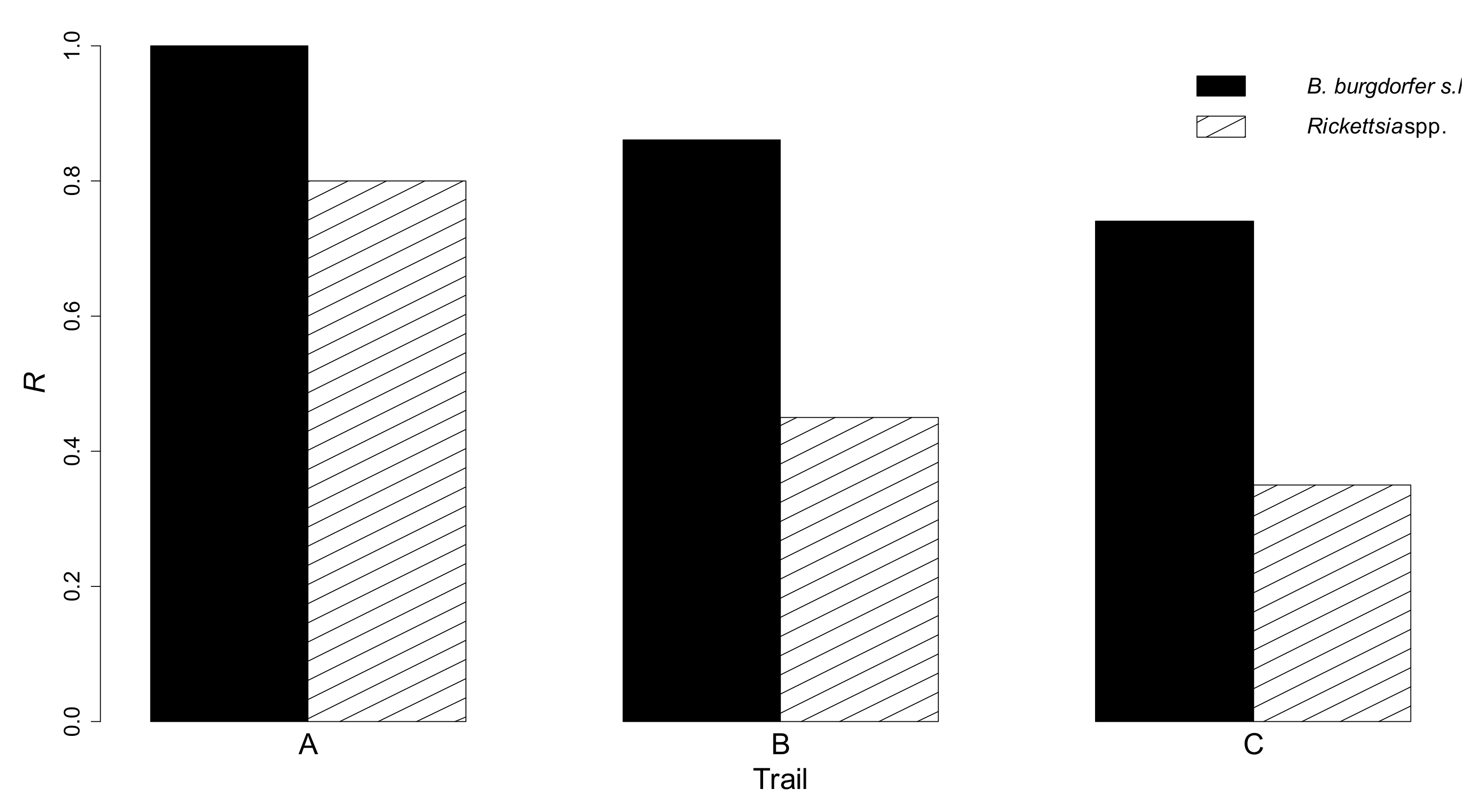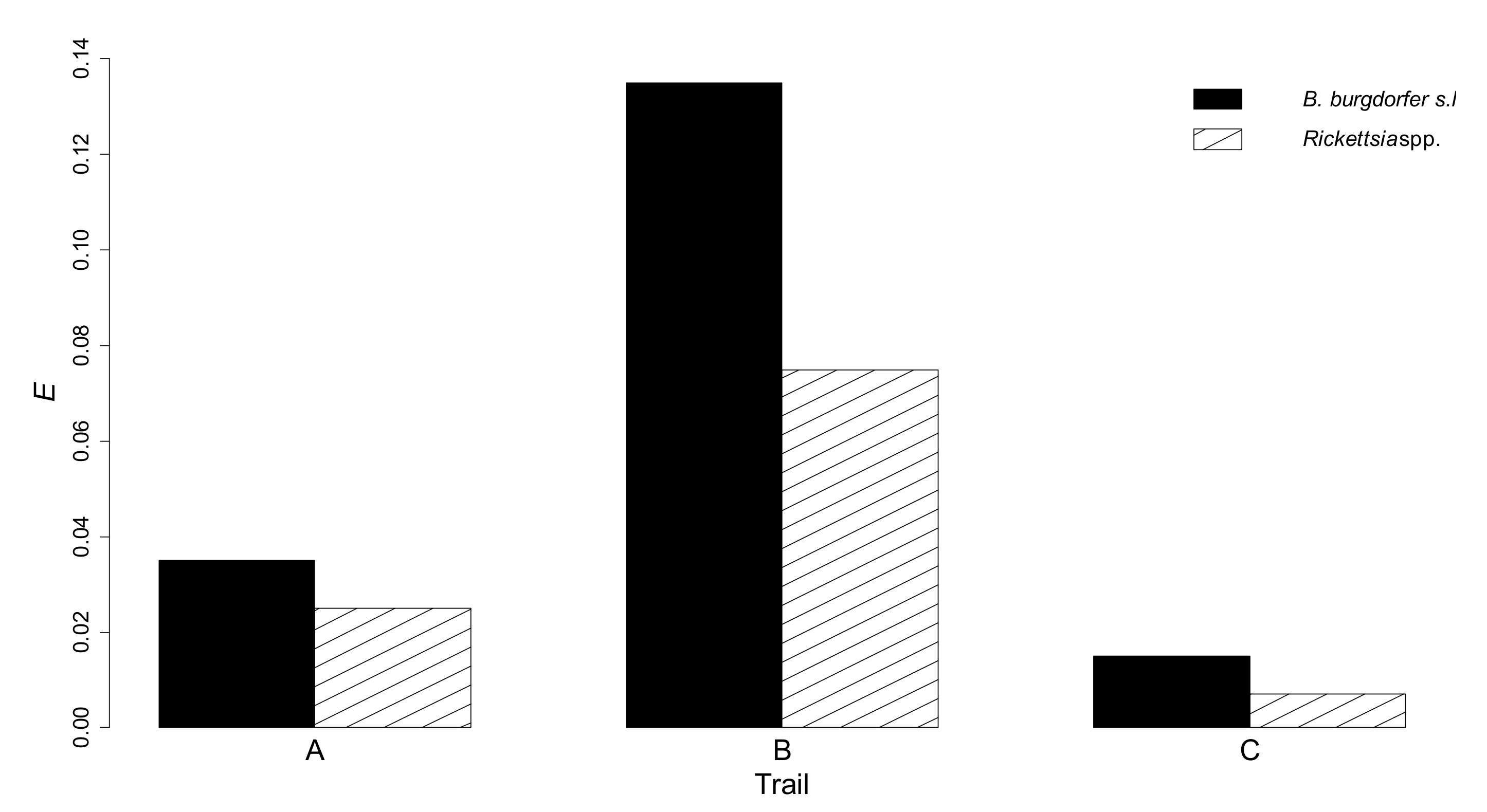Assessment of the Exposure of People to Questing Ticks Carrying Agents of Zoonoses in Aosta Valley, Italy
Abstract
:1. Introduction
2. Materials and Methods
2.1. Hazard Characterization
2.1.1. Ticks Collection
2.1.2. Molecular Analysis
2.2. Release Assessment
2.3. Exposure Assessment
2.3.1. Probability of Exposure (E)
2.3.2. Questionnaire
3. Results
3.1. Hazard Characterization
3.2. Release Assessment
3.3. Exposure Assessment
4. Discussion
5. Conclusions
Author Contributions
Funding
Acknowledgments
Conflicts of Interest
References
- Wall, R.; Shearer, D. Veterinary Ectoparasites: Biology, Pathology and Control, 2nd ed, 2nd ed.; Blackwell Science Ltd.: Oxford, UK, 2001; ISBN 0-632-05618-5. [Google Scholar]
- Parola, P.; Raoult, D. Tick-borne bacterial diseases emerging in Europe. Clin. Microbiol. Infect. 2001, 7, 80–83. [Google Scholar] [CrossRef] [PubMed] [Green Version]
- Foldvari, G. Life cycle and ecology of Ixodes ricinus: The roots of public health importance. In Ecology and Prevention of Lyme Borreliosis, 1st ed.; Braks, M.A.H., Van Wieren, S.E., Takken, W., Sprong, H., Eds.; Wageningen Academic Publishers: Wageningen, The Netherlands, 2016; Volume 4, pp. 31–40. ISBN 978-90-8686-293-1. [Google Scholar] [CrossRef]
- Burri, C.; Cadenas, F.M.; Douet, V.; Moret, J.; Gern, L. Ixodes ricinus Density and Infection Prevalence of Borrelia burgdorferi Sensu Lato Along A North-Facing Altitudinal Gradient in The Rhône Valley (Switzerland). Vector-Borne Zoonotic Dis. 2007, 7, 50–58. [Google Scholar] [CrossRef] [PubMed]
- Pintore, M.D.; Ceballos, L.; Iulini, B.; Tomassone, L.; Pautasso, A.; Corbellini, D.; Rizzo, F.; Mandola, M.L.; Bardelli, M.; Peletto, S.; et al. Detection of Invasive Borrelia burgdorferi Strains in North-Eastern Piedmont, Italy. Zoonoses Public Health 2015, 62, 365–374. [Google Scholar] [CrossRef] [PubMed]
- Perez, C.; Rodhain, F. Biologie d’Ixodes ricinus L. 1758. Bull. Soc. Pathol. Exot. 1977, 70, 193–201. [Google Scholar]
- Nazzi, F.; Martinelli, E.; Del Fabbro, S.; Bernardinelli, I.; Milani, N.; Iob, A.; Pischiutti, P.; Campello, C.; D’Agaro, P. Ticks and Lyme borreliosis in an alpine area in northeast Italy. Med. Vet. Entomol. 2010, 24, 220–226. [Google Scholar] [CrossRef] [PubMed]
- Baráková, I.; Derdáková, M.; Selyemová, D.; Chvostáč, M.; Špitalská, E.; Rosso, F.; Collini, M.; Rosà, R.; Tagliapietra, V.; Girardi, M.; et al. Tick-borne pathogens and their reservoir hosts in northern Italy. Ticks Tick. Borne Dis. 2018, 9, 164–170. [Google Scholar] [CrossRef] [PubMed]
- Otranto, D.; Dantas-torres, F.; Giannelli, A.; Latrofa, M.S.; Cascio, A.; Cazzin, S.; Ravagnan, S.; Montarsi, F.; Zanzani, S.A.; Manfredi, M.T. Ticks infesting humans in Italy and associated pathogens. Parasit. Vectors 2014, 7, 328. [Google Scholar] [CrossRef]
- Ceballos, L.A.; Pintore, M.D.; Tomassone, L.; Pautasso, A.; Bisanzio, D.; Mignone, W.; Casalone, C.; Mannelli, A. Habitat and occurrence of ixodid ticks in the Liguria region, northwest Italy. Exp. Appl. Acarol. 2014, 64, 121–135. [Google Scholar] [CrossRef]
- Ravagnan, S.; Tomassone, L.; Montarsi, F.; Krawczyk, A.I.; Mastrorilli, E.; Sprong, H.; Milani, A.; Rossi, L.; Capelli, G. First detection of Borrelia miyamotoi in Ixodes ricinus ticks from northern Italy. Parasit. Vectors 2018, 11, 130. [Google Scholar] [CrossRef]
- Podio, S.; Ospedale Parini Azienda U.S.L. della Valle d’Aosta, Aosta, Italy. Personal communication, 2017.
- Rizzoli, A.; Silaghi, C.; Obiegala, A.; Rudolf, I.; Hubálek, Z.; Földvári, G.; Plantard, O.; Vayssier-Taussat, M.; Bonnet, S.; Špitalská, E.; et al. Ixodes ricinus and its transmitted pathogens in urban and peri-urban areas in Europe: New hazards and relevance for Public Health. Front. Public Health 2014, 2, 251. [Google Scholar] [CrossRef]
- EFSA Scientific Committee. Scientific Opinion on Risk Assessment Terminology. EFSA J. 2012, 10, 2664. [Google Scholar] [CrossRef] [Green Version]
- Regione Valle d’Aosta. Geonavigatore. Available online: http://geonavsct.partout.it/pub/GeoCartoSCT/index.html (accessed on 12 February 2019).
- Mannelli, A.; Bertolotti, L.; Gern, L.; Gray, J. Ecology of Borrelia burgdorferi sensu lato in Europe: Transmission dynamics in multi-host systems, influence of molecular processes and effects of climate change. FEMS Microbiol. Rev. 2012, 36, 837–861. [Google Scholar] [CrossRef]
- Manilla, G. Fauna d’Italia. Acari. Ixodida, 1st ed.; Edizioni Calderini: Bologna, Italy, 1998; ISBN 88-8219-162-1. [Google Scholar]
- Tomassone, L.; Ceballos, L.A.; Ragagli, C.; Martello, E.; Sousa, R.D.; Stella, M.C.; Mannelli, A. Importance of Common Wall Lizards in the Transmission Dynamics of Tick-Borne Pathogens in the Northern Apennine Mountains, Italy. Invertebr. Microbiol. 2017, 72, 741–986. [Google Scholar] [CrossRef] [PubMed]
- Mannelli, A.; Boggiatto, G.; Grego, E.; Cinco, M.; Murgia, R.; Stefanelli, S.; De Meneghi, D.; Rosati, S. Acarological Risk of Exposure to Agents of Tick-Borne Zoonoses in the First Recognized Italian Focus of Lyme Borreliosis. Epidemiol. Infect. 2003, 131, 1139–1147. [Google Scholar] [CrossRef] [PubMed]
- Verheyen, K.; Ruyts, S.C. How can forest managers help to reduce the risk for Lyme borreliosis. In Ecology and Prevention of Lyme Borreliosis, 1st ed.; Braks, M.A.H., Van Wieren, S.E., Takken, W., Sprong, H., Eds.; Wageningen Academic Publishers: Wageningen, The Netherlands, 2016; Volume 4, pp. 233–241. ISBN 978-90-8686-293-1. [Google Scholar] [CrossRef]
- Bowman, A.S.; Nuttall, P. Ticks Biology, Disease and Control, 1st ed.; Cambridge University Press: Cambridge, UK, 2008; ISBN 978-0521867610. [Google Scholar]
- Gilbert, L. Altitudinal patterns of tick and host abundance: A potential role for climate change in regulating tick-borne diseases? Oecologia 2010, 162, 217–225. [Google Scholar] [CrossRef]
- Rizzoli, A.; Merler, S.; Furlanello, C.; Genchi, C. Geographical information systems and bootstrap aggregation (bagging) of tree-based classifiers for Lyme disease risk prediction in Trentino, Italian Alps. J. Med. Entomol. 2002, 39, 485–492. [Google Scholar] [CrossRef] [PubMed]
- Cinco, M.; Padovan, D.; Murgia, R.; Poldini, L.; Frusteri, L.; van de Pol, I.; Verbeek-De Kruif, N.; Rijpkema, S.; Maroli, M. Rate of infection of Ixodes ricinus ticks with Borrelia burgdorferi sensu stricto, Borrelia garinii, Borrelia afzelii and group VS116 in an endemic focus of Lyme disease in Italy. Eur. J. Clin. Microbiol. Infect. Dis. 1998, 17, 90–94. [Google Scholar] [CrossRef] [PubMed]
- Van Duijvendijk, G.; Gort, G.; Takken, W. Rodents as hosts for Ixodes ricinus and Borrelia afzelii. In Ecology and Prevention of Lyme Borreliosis, 1st ed.; Braks, M.A.H., Van Wieren, S.E., Takken, W., Sprong, H., Eds.; Wageningen Academic Publishers: Wageningen, The Netherlands, 2016; Volume 4, pp. 63–73. ISBN 978-90-8686-293-1. [Google Scholar] [CrossRef]
- Bonnet, S.I.; Paul, R.E.L.; Bischoff, E.; Cote, M.; Le Naour, E. First identification of Rickettsia helvetica in questing ticks from a French Northern Brittany Forest. PLoS Negl. Trop. Dis. 2017, 11, e0005416. [Google Scholar] [CrossRef]
- Hornok, S.; Kováts, D.; Csörgő, T.; Meli, M.L.; Gönczi, E.; Hadnagy, Z.; Takács, N.; Farkas, R.; Hofmann-Lemann, R. Birds as potential reservoirs of tick-borne pathogens: First evidence of bacteraemia with Rickettsia helvetica. Parasit. Vectors 2014, 7, 128. [Google Scholar] [CrossRef]
- Mejlon, H.A.; Jaenson, T.G.T. Questing behaviour of Ixodes ricinus ticks (Acari: Ixodidae). Exp. Appl. Acarol. 1997, 21, 747–754. [Google Scholar] [CrossRef]
- Rulison, E.L.; Kuczaj, I.; Pang, G.; Hickling, G.J.; Tsao, J.I.; Ginsberg, H.S. Flagging versus dragging as sampling methods for nymphal Ixodes scapularis (Acari: Ixodidae). J. Vector Ecol. 2013, 28, 163–167. [Google Scholar] [CrossRef] [PubMed]




| Trail | DTwalking | DT | c | VH | v | R | E | ||
|---|---|---|---|---|---|---|---|---|---|
| Bb | Rick | Bb | Rick | ||||||
| A | 0.75 | 10.5 | 0.07 | 0.5 | 0.39 | 0.99 | 0.80 | 0.035 | 0.028 |
| B | 0.2 | 2.6 | 0.08 | 2 | 0.86 | 0.85 | 0.46 | 0.136 | 0.074 |
| C | 0.25 | 3 | 0.08 | 0.25 | 0.22 | 0.75 | 0.37 | 0.015 | 0.007 |
© 2019 by the authors. Licensee MDPI, Basel, Switzerland. This article is an open access article distributed under the terms and conditions of the Creative Commons Attribution (CC BY) license (http://creativecommons.org/licenses/by/4.0/).
Share and Cite
Millet, I.; Ragionieri, M.; Tomassone, L.; Trentin, C.; Mannelli, A. Assessment of the Exposure of People to Questing Ticks Carrying Agents of Zoonoses in Aosta Valley, Italy. Vet. Sci. 2019, 6, 28. https://doi.org/10.3390/vetsci6010028
Millet I, Ragionieri M, Tomassone L, Trentin C, Mannelli A. Assessment of the Exposure of People to Questing Ticks Carrying Agents of Zoonoses in Aosta Valley, Italy. Veterinary Sciences. 2019; 6(1):28. https://doi.org/10.3390/vetsci6010028
Chicago/Turabian StyleMillet, Ilary, Marco Ragionieri, Laura Tomassone, Claudio Trentin, and Alessandro Mannelli. 2019. "Assessment of the Exposure of People to Questing Ticks Carrying Agents of Zoonoses in Aosta Valley, Italy" Veterinary Sciences 6, no. 1: 28. https://doi.org/10.3390/vetsci6010028
APA StyleMillet, I., Ragionieri, M., Tomassone, L., Trentin, C., & Mannelli, A. (2019). Assessment of the Exposure of People to Questing Ticks Carrying Agents of Zoonoses in Aosta Valley, Italy. Veterinary Sciences, 6(1), 28. https://doi.org/10.3390/vetsci6010028






